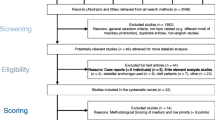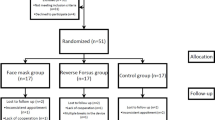Abstract
Objective
The objective of the present study is to test the null hypotheses that there were no significant differences for hard and soft tissue changes induced by mini maxillary protractor (MMP) and face mask and rapid maxillary expansion (FM/RME).
Materials and methods
Thirty-two patients who met the criteria were randomly divided into two groups: 16 patients (males/females 7/9) in the MMP group and 16 patients (males/females 6/10) in the FM/RME group. The patients in both groups were instructed to wear the appliances for at least 20 h per day until a 2-mm positive overjet was achieved. Hard and soft tissue profile changes observed by MMP and FM/RME were compared using paired and Student’s t tests.
Results
Class III malocclusion and negative overjet were improved by means of skeletal changes in conjunction with upper incisor proclination and lower incisor retroclination in both groups. Maxilla and surrounding soft tissues (SNA, Ls-E, and Ls-PMV) were significantly moved anteriorly with less rotation of the palatal plane in the MMP group. Mandibular incisors were found to be more retrusive in the FM/RME group (p = 0.024).
Conclusion
Both groups showed similar effects except more anterior movement of the maxilla and surrounding soft tissues with less rotation of the palatal plane and retrusion of lower incisors in the MMP group.
Clinical relevance
This is the first study to compare the soft and hard tissue changes induced by MMP appliance with a conventional FM /RME.




Similar content being viewed by others
References
Fu M, Zhang D, Wang B, Deng Y, Wang F, Ye X (2002) The prevalence of malocclusion in China—an investigation of 25,392 children. Zhonghua Kou Qiang Yi Xue Za Zhi 37:371–3
Irie M, Nakamura S (1975) Orthopedic Approach to severe skeletal Class-III malocclusion. Am J Orthod Dentofac 67:377–92
Guyer EC, Ellis EE 3rd, McNamara JA Jr (1986) Behrents RG. Components of Class III malocclusion in juveniles and adolescents. Angle Orthod 56:7–30
Kilic N, Catal G, Kiki A, Oktay H (2010) Soft tissue profile changes following maxillary protraction in Class III subjects. Eur J Orthod 32:419–24
Campbell PM (1983) The dilemma of Class III treatment. Early or late? Angle Orthod 53:175–91
Sung SJ, Baik HS (1998) Assessment of skeletal and dental changes by maxillary protraction. Am J Orthod Dentofac 114:492–502
Ucuncu N, Ucem TT, Yuksel S (2000) A comparison of chincap and maxillary protraction appliances in the treatment of skeletal Class III malocclusions. Eur J Orthod 22:43–51
Yuksel S, Ucem TT, Keykubat A (2001) Early and late facemask therapy. Eur J Orthod 23:559–68
Alcan T, Keles A, Erverdi N (2000) The effects of a modified protraction headgear on maxilla. Am J Orthod Dentofac 117:27–38
Altug Z, Arslan AD (2005) A mini-maxillary protractor for Class III correction. J Clin Orthod 39:522–5
Kajiyama K, Murakami T, Suzuki A (2000) Evaluation of the modified maxillary protractor applied to Class III malocclusion with retruded maxilla in early mixed dentition. Am J Orthod Dentofac 118:549–59
Kilic N, Celikoglu M, Oktay H (2010) Effects of the functional regulator III on profile changes in subjects with maxillary deficiency. Eur J Orthod 32:729–34
Kilic N, Celikoglu M, Oktay H (2011) Effects of the functional regulator III on transversal changes: a postero-anterior cephalometric and model study. Eur J Orthod 33:727–31
Kilicoglu H, Kirlic Y (1998) Profile changes in patients with class III malocclusions after Delaire mask therapy. Am J Orthod Dentofac 113:453–62
Kircelli BH, Pektas ZO (2008) Midfacial protraction with skeletally anchored face mask therapy: a novel approach and preliminary results. Am J Orthod Dentofac 133:440–9
Celikoglu M, Oktay H (2014) Effects of maxillary protraction for early correction of Class III malocclusion. Eur J Orthod 36:86–92
Altug Z, Akcam OU (2010) Treatment of a young adult with Class III malocclusion using a modified mini maxillary protractor: a case report. J Oral Sci 52:155–9
Altug Z, Arslan AD (2006) Skeletal and dental effects of a mini maxillary protraction appliance. Angle Orthod 76:360–8
Houston WJ (1983) The analysis of errors in orthodontic measurements. Am J Orthod 83:382–90
Lee NK, Yang IH, Baek SH (2012) The short-term treatment effects of face mask therapy in Class III patients based on the anchorage device: miniplates vs rapid maxillary expansion. Angle Orthod 82:846–52
Baccetti T, McGill JS, Franchi L, McNamara JA Jr (1998) Tollaro I. Skeletal effects of early treatment of Class III malocclusion with maxillary expansion and face-mask therapy. Am J Orthod Dentofac 113:333–43
Baik HS (1995) Clinical results of the maxillary protraction in Korean children. Am J Orthod Dentofac 108:583–92
Haas AJ (1965) The treatment of maxillary deficiency by opening the midpalatal suture. Angle Orthod 35:200–17
Kurt G, Uysal T, Yagci A (2010) Soft and hard tissue profile changes after rapid maxillary expansion and face mask therapy. World J Orthod 11:e10–8
McNamara JA Jr (1987) An orthopedic approach to the treatment of Class III malocclusion in young patients. J Clin Orthod 21:598–608
Turley PK (1988) Orthopedic correction of Class III malocclusion with palatal expansion and custom protraction headgear. J Clin Orthod 22:314–25
Arman A, Ufuk Toygar T, Abuhijleh E (2006) Evaluation of maxillary protraction and fixed appliance therapy in Class III patients. Eur J Orthod 28:383–92
Ngan P, Hagg U, Yiu C, Merwin D, Wei SH (1996) Treatment response to maxillary expansion and protraction. Eur J Orthod 18:151–68
Shanker S, Ngan P, Wade D, Beck M, Yiu C, Hagg U et al (1996) Cephalometric A point changes during and after maxillary protraction and expansion. Am J Orthod Dentofac 110:423–30
Sarver DM, Johnston MW (1989) Skeletal changes in vertical and anterior displacement of the maxilla with bonded rapid palatal expansion appliances. Am J Orthod Dentofacial Orthop 95:462–6
Ngan P, Hagg U, Yiu C, Merwin D, Wei SH (1996) Soft tissue and dentoskeletal profile changes associated with maxillary expansion and protraction headgear treatment. Am J Orthod Dentofac 109:38–49
Yavuz I, Halicioglu K, Ceylan I (2009) Face mask therapy effects in two skeletal maturation groups of female subjects with skeletal Class III malocclusions. Angle Orthod 79:842–8
Merwin D, Ngan P, Hagg U, Yiu C, Wei SH (1997) Timing for effective application of anteriorly directed orthopedic force to the maxilla. Am J Orthod Dentofac 112:292–9
Cha BK, Choi DS, Ngan P, Jost-Brinkmann PG, Kim SM, Jang IS (2011) Maxillary protraction with miniplates providing skeletal anchorage in a growing Class III patient. Am J Orthod Dentofac 139:99–112
Canturk BH, Celikoglu M (2014) Comparison of the effects of face mask treatment started simultaneously and after the completion of the alternate rapid maxillary expansion and constriction procedure. Angle Orthod
Conflict of interest
The authors declare that they have no conflict of interest.
Author contribution
Mevlut Celikoglu treated the patients, planned the study, and documented the article. Ibrahim Yavuz treated the patients, performed the statistical analyses, and revised article. Tuba Unal collected the data, performed the measurements, and prepared the figures and tables. Husamettin Oktay planned and edited the article and helped for revision. Abdulvahit Erdem edited the article and helped for revision.
Author information
Authors and Affiliations
Corresponding author
Rights and permissions
About this article
Cite this article
Celikoglu, M., Yavuz, I., Unal, T. et al. Comparison of the soft and hard tissue effects of two different protraction mechanisms in class III patients: a randomized clinical trial. Clin Oral Invest 19, 2115–2122 (2015). https://doi.org/10.1007/s00784-015-1408-5
Received:
Accepted:
Published:
Issue Date:
DOI: https://doi.org/10.1007/s00784-015-1408-5




